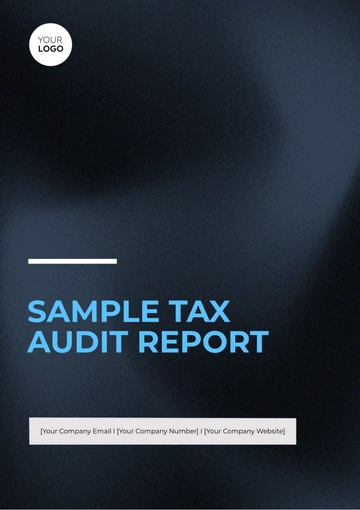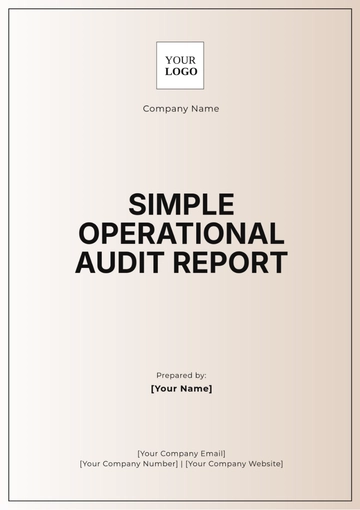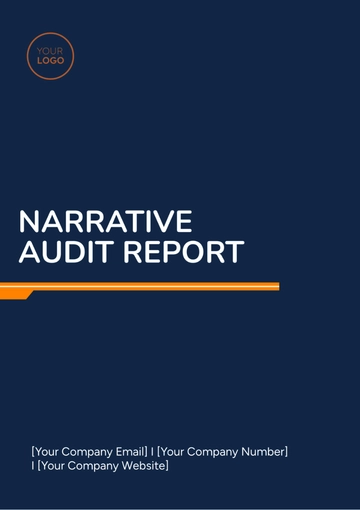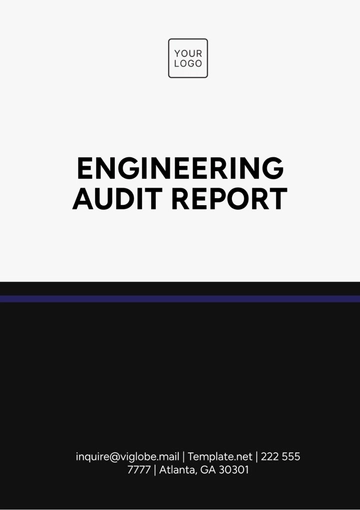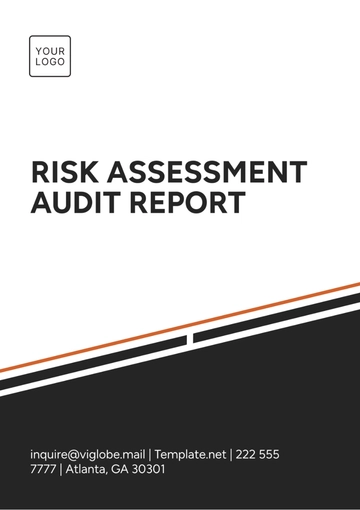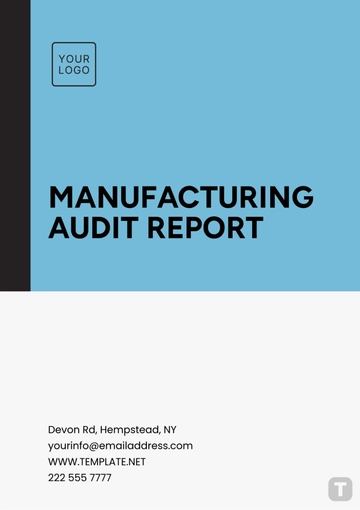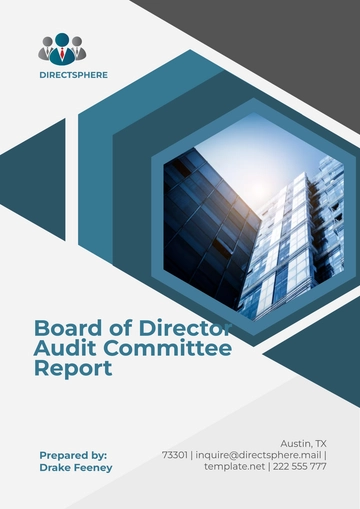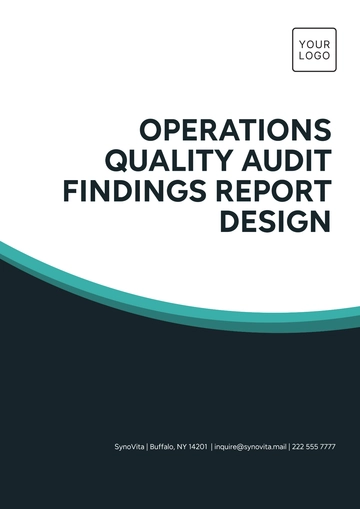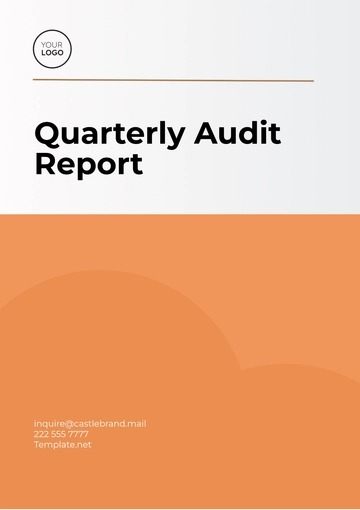Free Agriculture Environmental Compliance Report

I. Introduction
Environmental compliance is critical for sustainable agricultural practices and regulatory adherence. This report outlines [Your Company Name]'s current environmental compliance status, detailing the measures taken and areas requiring improvement. The aim is to ensure our operations align with environmental regulations and promote eco-friendly farming practices.
A. Purpose of the Report
Assess Compliance: To evaluate our adherence to environmental regulations and standards. This assessment helps in identifying compliance gaps and areas needing corrective actions.
Highlight Achievements: To document the environmental initiatives and improvements made by [Your Company Name]. Showcasing our progress highlights our commitment to sustainability.
Identify Risks: To identify potential environmental risks associated with our operations. Addressing these risks ensures the protection of natural resources and mitigates legal liabilities.
Guide Future Actions: To provide a roadmap for future environmental actions and strategies. This guide helps in planning sustainable practices and continuous improvement.
B. Scope of the Report
Regulatory Compliance: The report covers compliance with local, national, and international environmental regulations. This ensures our operations meet all legal requirements.
Environmental Impact: The analysis includes the impact of our agricultural activities on the environment. This includes soil health, water usage, and biodiversity.
Sustainability Practices: The report evaluates the sustainability practices implemented in our operations. This includes waste management, energy use, and conservation efforts.
Compliance Monitoring: The scope extends to the monitoring systems in place to track compliance. Effective monitoring ensures ongoing adherence to environmental standards.
C. Methodology
Data Collection: Collected data from various sources including field reports, regulatory documents, and environmental assessments. Accurate data collection is crucial for a reliable analysis.
Stakeholder Interviews: Conducted interviews with key stakeholders such as farmers, regulatory authorities, and environmental experts. These interviews provide insights into compliance status and challenges.
Site Inspections: Performed site inspections to observe practices and verify compliance on the ground. Inspections help in identifying non-compliance issues and areas for improvement.
Data Analysis: Analyzed the collected data to identify trends, compliance levels, and areas requiring corrective actions. Data analysis provides a comprehensive understanding of our environmental impact.
Reporting: Compiled the findings into a detailed report with recommendations for improvement. The report serves as a reference for decision-making and future actions.
II. Regulatory Compliance
A. Local Regulations
The following table summarizes our compliance with local environmental regulations:
Regulation | Requirement | Compliance Status | Notes |
|---|---|---|---|
Water Usage | Limit on water extraction from local sources | Compliant | Efficient irrigation systems in place |
Pesticide Use | Restrictions on pesticide types and quantities | Partially Compliant | Need to reduce certain pesticide usage |
Waste Management | Proper disposal and recycling of waste | Non-Compliant | Improvement needed in waste segregation |
Emission Controls | Limits on greenhouse gas emissions | Compliant | Low-emission equipment used |
Water Usage: Our compliance with water usage regulations reflects our efficient irrigation practices, which minimize water extraction and ensure sustainable use of local water resources.
Pesticide Use: While we are partially compliant with pesticide regulations, there is a need to reduce the usage of certain pesticides to fully comply with environmental standards.
Waste Management: Non-compliance in waste management indicates a need for better waste segregation and recycling practices to meet local regulatory requirements.
Emission Controls: Compliance with emission control regulations shows our commitment to using low-emission equipment and reducing greenhouse gas emissions.
Maintaining compliance with local regulations is essential for legal adherence and environmental stewardship. By addressing non-compliance areas such as waste management and pesticide use, we can improve our overall environmental impact.
B. National Regulations
Soil Health: Compliance with regulations ensuring soil health through sustainable farming practices. This involves crop rotation, organic fertilizers, and soil testing.
Water Quality: Adherence to water quality standards to prevent contamination from agricultural runoff. Regular water testing and filtration systems are implemented.
Wildlife Protection: Compliance with national laws protecting local wildlife and their habitats. This includes maintaining buffer zones and avoiding harmful practices.
Chemical Use: Regulations on the use of agricultural chemicals and their disposal. Ensuring safe storage, application, and disposal of chemicals to prevent environmental harm.
C. International Regulations
Sustainability Certification: Obtaining certifications such as Global GAP and USDA Organic to meet international sustainability standards. These certifications enhance marketability and ensure high environmental standards.
Trade Regulations: Compliance with environmental regulations of export markets. This includes meeting the environmental criteria set by international trade agreements.
Global Reporting: Adhering to international reporting standards such as the Global Reporting Initiative (GRI). This ensures transparency and accountability in environmental reporting.
Climate Agreements: Compliance with international climate agreements like the Paris Agreement. This involves implementing practices to reduce carbon footprint and mitigate climate change.
Ensuring compliance with national and international regulations is crucial for maintaining market access and enhancing our environmental reputation. By adhering to these standards, we demonstrate our commitment to sustainable and responsible farming practices.
III. Environmental Impact Assessment
A. Soil Health
The following table summarizes the soil health assessment results:
Parameter | Measurement | Ideal Range | Current Status | Notes |
|---|---|---|---|---|
pH Level | Soil acidity/alkalinity | 6.0 - 7.5 | 6.8 | Within ideal range |
Organic Matter | Percentage of organic material | > 3% | 2.5% | Slightly below ideal range |
Nutrient Levels | Concentrations of N, P, K | Balanced | Unbalanced (Low P) | Need to increase phosphorus levels |
Soil Erosion | Rate of soil loss | Minimal | Moderate | Implement erosion control measures |
pH Level: The soil pH level of 6.8 is within the ideal range, indicating balanced soil acidity/alkalinity, which is essential for optimal plant growth.
Organic Matter: The organic matter content of 2.5% is slightly below the ideal range, suggesting a need to incorporate more organic material to enhance soil fertility.
Nutrient Levels: Unbalanced nutrient levels, particularly low phosphorus, highlight the need for targeted fertilization to ensure proper nutrient availability for crops.
Soil Erosion: Moderate soil erosion indicates the need for erosion control measures to prevent soil loss and maintain soil health.
Maintaining soil health is critical for sustainable agricultural production. By addressing nutrient imbalances, increasing organic matter, and implementing erosion control measures, [Your Company Name] can enhance soil fertility and productivity.
B. Water Usage
Irrigation Efficiency: Implementing efficient irrigation systems to minimize water usage and ensure sustainable water management.
Water Conservation: Adopting water conservation practices such as rainwater harvesting and drip irrigation to reduce reliance on external water sources.
Water Quality: Monitoring water quality to prevent contamination and ensure safe water usage for irrigation and livestock.
Regulatory Compliance: Ensuring compliance with water usage regulations to prevent over-extraction and protect local water resources.
C. Air Quality
Emission Reduction: Implementing practices to reduce greenhouse gas emissions from agricultural activities. This includes using low-emission equipment and renewable energy sources.
Dust Control: Managing dust levels through practices such as cover crops and windbreaks to prevent air quality degradation.
Pesticide Application: Ensuring safe and controlled pesticide application to prevent air pollution and protect worker health.
Monitoring Systems: Installing air quality monitoring systems to track and manage air pollutants from farming operations.
D. Biodiversity
Habitat Conservation: Preserving natural habitats and promoting biodiversity through sustainable farming practices. This includes maintaining buffer zones and protecting wildlife corridors.
Crop Diversity: Implementing crop rotation and diversification to enhance biodiversity and reduce pest pressures.
Pollinator Support: Creating habitats and planting pollinator-friendly crops to support pollinator populations and biodiversity.
Invasive Species Control: Managing invasive species to protect native biodiversity and prevent ecosystem disruption.
Assessing the environmental impact of our agricultural operations helps in identifying areas for improvement and implementing sustainable practices. By focusing on soil health, water usage, air quality, and biodiversity, [Your Company Name] can minimize its environmental footprint and promote eco-friendly farming.
IV. Sustainability Practices
A. Energy Use
The following table outlines our energy usage and sustainability practices:
Energy Source | Usage (kWh) | Sustainability Practice | Notes |
|---|---|---|---|
Electricity | 150,000 kWh | Renewable energy (solar panels) | Reduce reliance on non-renewable sources |
Diesel | 20,000 liters | Fuel-efficient machinery | Lower emissions and fuel consumption |
Natural Gas | 50,000 m³ | Energy-efficient heating systems | Reduce greenhouse gas emissions |
Biomass | 30,000 kg | Biomass energy production | Utilize waste for energy generation |
Electricity: Using renewable energy sources such as solar panels helps reduce reliance on non-renewable electricity and lowers carbon emissions.
Diesel: Implementing fuel-efficient machinery reduces diesel consumption and lowers emissions, contributing to cleaner air and reduced carbon footprint.
Natural Gas: Using energy-efficient heating systems decreases natural gas usage and greenhouse gas emissions, promoting sustainability.
Biomass: Utilizing biomass for energy production converts waste into a valuable energy source, reducing waste and supporting circular economy practices.
Sustainable energy use is crucial for reducing the environmental impact of agricultural operations. By implementing renewable energy sources, fuel-efficient machinery, and energy-efficient systems, [Your Company Name] can lower its carbon footprint and promote sustainable practices.
B. Waste Management
Waste Segregation: Implementing waste segregation practices to separate recyclable, compostable, and hazardous waste. Proper segregation ensures efficient waste disposal and recycling.
Composting: Establishing composting systems to convert organic waste into valuable compost for soil enrichment. Composting reduces landfill waste and enhances soil fertility.
Recycling Programs: Implementing recycling programs for plastics, metals, and other recyclable materials. Recycling reduces waste and conserves resources.
Hazardous Waste Disposal: Ensuring safe disposal of hazardous waste to prevent environmental contamination. Proper disposal protects soil and water quality.
C. Conservation Efforts
Water Conservation: Implementing water conservation practices such as rainwater harvesting and efficient irrigation systems. Conservation efforts reduce water usage and protect local water resources.
Soil Conservation: Adopting soil conservation practices such as cover cropping, no-till farming, and erosion control measures. Soil conservation enhances soil health and prevents degradation.
Wildlife Conservation: Protecting wildlife habitats and promoting biodiversity through sustainable farming practices. Conservation efforts support ecosystem health and biodiversity.
Energy Conservation: Implementing energy conservation practices to reduce energy usage and promote efficiency. Conservation efforts lower greenhouse gas emissions and energy costs.
D. Sustainable Agriculture Practices
Crop Rotation: Implementing crop rotation to enhance soil health, reduce pest pressures, and promote biodiversity. Crop rotation supports sustainable farming practices.
Cover Cropping: Using cover crops to protect soil, enhance fertility, and prevent erosion. Cover cropping improves soil health and reduces environmental impact.
Integrated Pest Management: Adopting integrated pest management (IPM) practices to control pests using environmentally friendly methods. IPM reduces reliance on chemical pesticides.
Organic Farming: Implementing organic farming practices to reduce chemical inputs and promote soil health. Organic farming supports sustainability and environmental protection.
V. Compliance Monitoring
A. Monitoring Systems
The following table outlines our environmental compliance monitoring systems:
Monitoring System | Parameter Monitored | Frequency | Notes |
|---|---|---|---|
Soil Testing | Soil health parameters (pH, nutrients, etc.) | Quarterly | Ensures soil health and nutrient balance |
Water Testing | Water quality (pH, contaminants, etc.) | Monthly | Ensures safe water usage and compliance |
Air Quality Monitoring | Air pollutants (particulate matter, emissions) | Monthly | Ensures clean air and regulatory compliance |
Wildlife Surveys | Biodiversity and habitat health | Annually | Ensures wildlife protection and biodiversity |
Soil Testing: Quarterly soil testing ensures that soil health parameters such as pH and nutrient levels are within the optimal range. This practice supports sustainable farming and soil fertility.
Water Testing: Monthly water testing monitors water quality, ensuring safe usage and compliance with environmental regulations. Regular testing prevents contamination and protects water resources.
Air Quality Monitoring: Monthly air quality monitoring tracks air pollutants, ensuring clean air and compliance with emission standards. Monitoring helps in managing air quality and reducing pollution.
Wildlife Surveys: Annual wildlife surveys assess biodiversity and habitat health, ensuring the protection of local wildlife and promoting biodiversity. Surveys help in maintaining ecological balance.
Effective compliance monitoring is essential for maintaining environmental standards and identifying areas for improvement. By implementing robust monitoring systems, [Your Company Name] can ensure ongoing compliance and promote sustainable agricultural practices.
B. Compliance Reporting
Regular Reporting: Submitting regular environmental compliance reports to regulatory authorities. Reporting ensures transparency and accountability.
Stakeholder Communication: Communicating compliance status and initiatives to stakeholders, including employees, customers, and the community. Effective communication builds trust and supports sustainability efforts.
Performance Metrics: Tracking performance metrics to assess compliance levels and identify areas needing improvement. Metrics provide a basis for continuous improvement.
Corrective Actions: Implementing corrective actions to address non-compliance issues and improve environmental performance. Proactive actions ensure ongoing compliance.
C. Audit and Review
Internal Audits: Conducting internal environmental audits to assess compliance and identify gaps. Audits provide insights for improvement.
External Audits: Engaging third-party auditors to conduct external environmental audits. External audits ensure objectivity and credibility.
Continuous Improvement: Implementing a continuous improvement process to regularly review and update compliance practices. Continuous improvement supports sustainability and compliance.
Benchmarking: Benchmarking against industry standards and best practices to ensure high compliance levels. Benchmarking helps in adopting leading practices.
Monitoring and reporting compliance status ensures that [Your Company Name] maintains high environmental standards and identifies opportunities for improvement. Regular audits and reviews support continuous improvement and sustainable practices.
VI. Risk Management
A. Identifying Environmental Risks
The following table outlines identified environmental risks and mitigation measures:
Risk | Potential Impact | Mitigation Measure | Notes |
|---|---|---|---|
Soil Degradation | Reduced soil fertility and productivity | Implement soil conservation practices | Cover cropping and no-till farming |
Water Contamination | Unsafe water usage and regulatory non-compliance | Regular water testing and filtration | Prevent contamination and ensure safety |
Air Pollution | Health hazards and regulatory non-compliance | Use low-emission equipment | Reduce emissions and improve air quality |
Habitat Destruction | Loss of biodiversity and ecosystem disruption | Maintain buffer zones and habitats | Protect wildlife and promote biodiversity |
Soil Degradation: Implementing soil conservation practices such as cover cropping and no-till farming helps prevent soil degradation, maintaining soil fertility and productivity.
Water Contamination: Regular water testing and filtration prevent water contamination, ensuring safe usage and compliance with environmental regulations.
Air Pollution: Using low-emission equipment reduces air pollution, mitigating health hazards and ensuring compliance with emission standards.
Habitat Destruction: Maintaining buffer zones and natural habitats protects biodiversity and prevents ecosystem disruption, promoting ecological balance.
Effective risk management is crucial for mitigating environmental risks and ensuring sustainable agricultural practices. By implementing mitigation measures, [Your Company Name] can minimize environmental impact and protect natural resources.
B. Risk Mitigation Strategies
Preventive Measures: Implementing preventive measures to avoid environmental risks. This includes regular maintenance of equipment, proper waste disposal, and sustainable farming practices.
Emergency Response Plans: Developing and implementing emergency response plans to address environmental incidents. Response plans ensure quick and effective action to mitigate impact.
Training and Awareness: Conducting training sessions and awareness programs for employees on environmental risks and mitigation strategies. Education promotes proactive risk management.
Monitoring and Evaluation: Regularly monitoring and evaluating risk management practices to ensure effectiveness. Continuous evaluation supports ongoing improvement.
Stakeholder Engagement: Engaging stakeholders in risk management efforts. Collaboration enhances risk mitigation and promotes shared responsibility.
VII. Financial Implications
A. Environmental Compliance Costs
The following chart and table outline the costs associated with environmental compliance:
Expense Category | Cost | Notes |
|---|---|---|
Compliance Monitoring | $50,000 | Includes soil, water, and air quality testing |
Waste Management | $30,000 | Includes waste segregation and disposal |
Energy Efficiency | $40,000 | Includes installation of renewable energy systems |
Soil Conservation | $20,000 | Includes cover cropping and erosion control |
Water Conservation | $25,000 | Includes rainwater harvesting and drip irrigation |
Compliance Monitoring: The cost of $50,000 for compliance monitoring includes regular soil, water, and air quality testing. This ensures ongoing adherence to environmental standards.
Waste Management: The $30,000 cost for waste management covers waste segregation, disposal, and recycling programs. Effective waste management reduces environmental impact and promotes sustainability.
Energy Efficiency: Investing $40,000 in energy efficiency includes the installation of renewable energy systems such as solar panels. This reduces reliance on non-renewable energy and lowers emissions.
Soil Conservation: The $20,000 cost for soil conservation includes practices like cover cropping and erosion control. These practices enhance soil health and prevent degradation.
Water Conservation: Spending $25,000 on water conservation includes rainwater harvesting and drip irrigation systems. These practices reduce water usage and promote sustainable water management.
Understanding the financial implications of environmental compliance helps [Your Company Name] allocate resources effectively and plan for sustainable practices. By investing in compliance measures, we can ensure long-term environmental sustainability and regulatory adherence.
B. Return on Investment (ROI)
Cost Savings: Implementing energy-efficient systems and waste management practices results in long-term cost savings. Reduced energy consumption and waste disposal costs enhance profitability.
Regulatory Compliance: Adhering to environmental regulations prevents fines and legal liabilities. Compliance reduces financial risks and enhances business stability.
Market Opportunities: Achieving sustainability certifications and compliance opens up new market opportunities. Consumers and businesses prefer environmentally responsible products.
Brand Reputation: Investing in environmental compliance enhances brand reputation. A strong reputation attracts customers, investors, and partners who value sustainability.
Resource Efficiency: Sustainable practices improve resource efficiency, reducing input costs and enhancing productivity. Efficient resource use supports long-term profitability.
VIII. Recommendations
A. Energy Use
Increase Renewable Energy Sources: Expand the use of solar and biomass energy to further reduce reliance on non-renewable energy sources. This will enhance sustainability and reduce carbon emissions.
Upgrade Machinery for Efficiency: Invest in newer, fuel-efficient machinery to lower diesel consumption. This upgrade will decrease emissions and operational costs.
Implement Energy Efficiency Measures: Adopt energy-efficient practices such as using LED lighting and optimizing equipment usage to reduce overall energy consumption and costs.
B. Waste Management
Enhance Waste Segregation Systems: Improve waste segregation systems to ensure all waste is appropriately sorted and managed. This will increase recycling rates and reduce landfill waste.
Expand Composting Programs: Increase the scale of composting programs to handle more organic waste. This will improve soil health and reduce the volume of waste sent to landfills.
Strengthen Hazardous Waste Protocols: Develop stricter protocols for the disposal of hazardous waste to prevent environmental contamination and ensure compliance with regulations.
Implement a Zero Waste Policy: Aim for a zero-waste policy by minimizing waste generation and maximizing recycling and reuse. This will significantly reduce the environmental footprint.
C. Conservation Efforts
Promote Water Conservation Techniques: Implement advanced water conservation techniques such as precision irrigation and rainwater harvesting. These practices will reduce water usage and preserve local water resources.
Adopt Soil Conservation Methods: Continue and expand the use of soil conservation methods like cover cropping and no-till farming to maintain soil health and prevent erosion.
Enhance Wildlife Conservation Initiatives: Increase efforts to protect wildlife habitats and promote biodiversity. This includes maintaining buffer zones and implementing biodiversity-friendly farming practices.
Invest in Energy Conservation Technologies: Adopt new technologies and practices to conserve energy, such as energy-efficient heating and cooling systems. This will lower energy consumption and costs.
D. Compliance Monitoring
Implement Advanced Monitoring Systems: Upgrade current monitoring systems to include more sophisticated technologies for real-time data collection. This will enhance compliance tracking and issue identification.
Increase Frequency of Testing: Conduct more frequent soil, water, and air quality tests to ensure ongoing compliance and promptly address any issues that arise.
Enhance Wildlife Monitoring: Implement more comprehensive wildlife monitoring programs to assess the impact of agricultural practices on biodiversity and habitat health.
Develop Automated Reporting Tools: Create automated tools for generating compliance reports. This will improve accuracy, efficiency, and timeliness in reporting to regulatory authorities.
E. Risk Management
Strengthen Preventive Measures: Increase preventive measures such as regular maintenance of equipment and improved waste disposal practices to mitigate environmental risks.
Develop Comprehensive Emergency Response Plans: Create detailed emergency response plans to effectively handle environmental incidents. These plans should be regularly tested and updated.
Enhance Training Programs: Expand training programs for employees to include more in-depth information on environmental risks and mitigation strategies. This will increase awareness and proactive risk management.
Implement Continuous Risk Evaluation: Regularly evaluate and update risk management practices to ensure they are effective and up-to-date with current best practices and regulatory requirements.
F. Financial Investments
Allocate Budget for Environmental Initiatives: Ensure a portion of the budget is dedicated to environmental compliance and sustainability initiatives. This will support the implementation of recommended practices.
Seek Grants and Incentives: Apply for government grants and incentives aimed at promoting sustainable agricultural practices. These funds can offset the costs of compliance measures.
Evaluate ROI for Sustainability Projects: Conduct regular ROI assessments for sustainability projects to ensure they are cost-effective and provide long-term financial and environmental benefits.
Invest in Compliance Training: Allocate resources for comprehensive training programs to ensure all employees are knowledgeable about compliance requirements and best practices.
By implementing these recommendations, [Your Company Name] can enhance its environmental compliance and sustainability efforts. These actions will not only ensure regulatory adherence but also promote long-term environmental stewardship and operational efficiency.
IX. Conclusion
This report has outlined [Your Company Name]'s compliance status, sustainability practices, risk management strategies, and financial implications. By adhering to environmental regulations and implementing sustainable practices, we ensure the long-term viability of our agricultural operations and contribute to environmental protection.
Moving forward, [Your Company Name] will continue to prioritize environmental compliance and sustainability. We will address identified compliance gaps, implement corrective actions, and enhance our sustainability initiatives. Regular monitoring, reporting, and stakeholder engagement will support continuous improvement and ensure ongoing compliance. Through these efforts, we aim to achieve our environmental goals and contribute to a sustainable future for agriculture.
- 100% Customizable, free editor
- Access 1 Million+ Templates, photo’s & graphics
- Download or share as a template
- Click and replace photos, graphics, text, backgrounds
- Resize, crop, AI write & more
- Access advanced editor
Environmental compliance reporting simplified with our Agriculture Environmental Compliance Report Template! Editable fields make adjustments easy, ensuring specific standards are met. Available on Template.net, this template is also customizable to fit your needs. The AI Editor Tool enhances the process, delivering an accurate and comprehensive report for your agricultural operations!
You may also like
- Sales Report
- Daily Report
- Project Report
- Business Report
- Weekly Report
- Incident Report
- Annual Report
- Report Layout
- Report Design
- Progress Report
- Marketing Report
- Company Report
- Monthly Report
- Audit Report
- Status Report
- School Report
- Reports Hr
- Management Report
- Project Status Report
- Handover Report
- Health And Safety Report
- Restaurant Report
- Construction Report
- Research Report
- Evaluation Report
- Investigation Report
- Employee Report
- Advertising Report
- Weekly Status Report
- Project Management Report
- Finance Report
- Service Report
- Technical Report
- Meeting Report
- Quarterly Report
- Inspection Report
- Medical Report
- Test Report
- Summary Report
- Inventory Report
- Valuation Report
- Operations Report
- Payroll Report
- Training Report
- Job Report
- Case Report
- Performance Report
- Board Report
- Internal Audit Report
- Student Report
- Monthly Management Report
- Small Business Report
- Accident Report
- Call Center Report
- Activity Report
- IT and Software Report
- Internship Report
- Visit Report
- Product Report
- Book Report
- Property Report
- Recruitment Report
- University Report
- Event Report
- SEO Report
- Conference Report
- Narrative Report
- Nursing Home Report
- Preschool Report
- Call Report
- Customer Report
- Employee Incident Report
- Accomplishment Report
- Social Media Report
- Work From Home Report
- Security Report
- Damage Report
- Quality Report
- Internal Report
- Nurse Report
- Real Estate Report
- Hotel Report
- Equipment Report
- Credit Report
- Field Report
- Non Profit Report
- Maintenance Report
- News Report
- Survey Report
- Executive Report
- Law Firm Report
- Advertising Agency Report
- Interior Design Report
- Travel Agency Report
- Stock Report
- Salon Report
- Bug Report
- Workplace Report
- Action Report
- Investor Report
- Cleaning Services Report
- Consulting Report
- Freelancer Report
- Site Visit Report
- Trip Report
- Classroom Observation Report
- Vehicle Report
- Final Report
- Software Report


